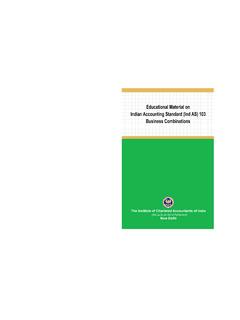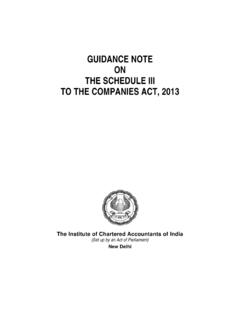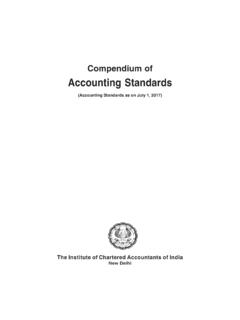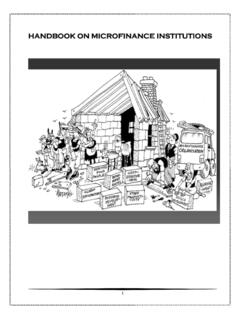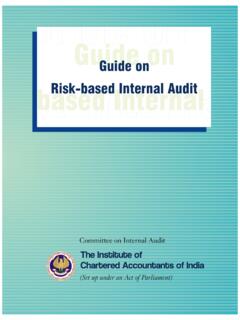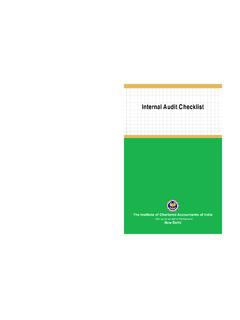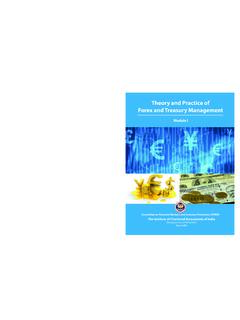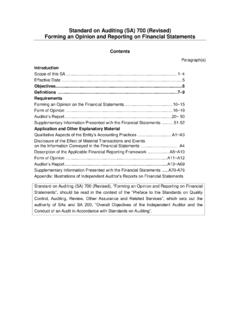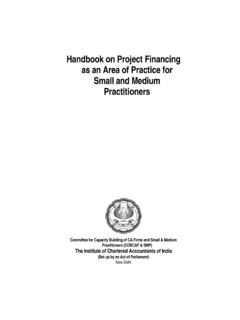Transcription of Technical Guide on Internal Audit of Pharmaceutical Industry
1 Technical Guide on Internal Audit of Pharmaceutical Industry DISCLAIMER: The views expressed in this Guide are those of author(s). The Institute of Chartered Accountants of India may not necessarily subscribe to the views expressed by the author(s). Internal Audit Standards Board The Institute of Chartered Accountants of India (Set up by an Act of Parliament) New Delhi The Institute of Chartered Accountants of India All rights reserved. No part of this publication may be reproduced, stored in a retrieval system, or transmitted, in any form, or by any means, electronic mechanical, photocopying, recording, or otherwise, without prior permission, in writing, from the publisher.
2 Edition : February, 2013 Committee/Department : Internal Audit Standards Board E-mail : Website : Price : ` 100/- (including CD) ISBN : 978-81-8441-345-8 Published by : The Publication Department on behalf of the Institute of Chartered Accountants of India, ICAI Bhawan, post Box No.
3 7100, Indraprastha Marg, New Delhi - 110 002. Printed by : Sahitya Bhawan Publications, Hospital Road, Agra - 282 003. August/2012/1,000 Copies Foreword Indian Pharmaceutical Industry has grown at a high pace during the last few years. The major challenges faced by the companies in the Pharmaceutical Industry are developing new products and services through research, shifting demographics, evolving governing regulations, transforming business models and increased expectations from stakeholders. Risk is central to Pharmaceutical companies as they are dependent on continuous research and development with long gestation periods, compliance issues with environmental laws, heavy capital investments as well as expenditures for environmental liabilities, management of their intellectual property rights, etc.
4 Most innovative Pharmaceutical companies are undergoing transition from their traditional business model and resort to diversification, mergers & acquisitions to deal with the growing competition for low cost generics. The Chartered accountants can play a crucial role in helping Pharmaceutical companies to address the said challenges presented by today s complex, competitive and risk driven environment by strategizing and channelizing the threats into opportunities and assist the management of the said companies in taking future course of action. I congratulate CA. Rajkumar S. Adukia, Chairman, Internal Audit Standards Board of The Institute of Chartered Accountants of India and other members of the Board for bringing out this Technical Guide on Internal Audit of Pharmaceutical Industry which is one of the rapidly growing industries of the country.
5 This comprehensive publication would surely help the members to conduct value added Internal audits and provide inputs that will help to improve operational efficiencies, risk management, capital allocation and market reach of the Pharmaceutical companies in the country. I am confident that the members and other interested readers will make best use of this publication. February 4, 2013 CA. Jaydeep Narendra Shah New Delhi President, ICAI Preface The Indian Pharmaceutical Industry is witnessing trends such as innovation in drugs at a faster pace, increasing investment, deeper penetration in rural markets, growth in insurance coverage and changing government regulations.
6 These positive trends, along with favourable macro environment will help to propel the Pharmaceutical Industry to the next level of growth. Pharmaceuticals companies are facing competition and they need to optimally leverage financial, relational, technology and reputational capital to create strategies and provide value to consumers. Keeping this in mind, the Internal Audit Standards Board is issuing the Technical Guide on Internal Audit of Pharmaceutical Industry , so as to provide guidance to Internal auditors in carrying out Internal Audit of companies operating in Pharmaceutical Industry .
7 The objective of this Technical Guide is to provide an insight into the functioning of the Pharmaceutical Industry , the key drivers of Pharmaceutical Industry , Technical aspects peculiar to the Industry and Internal Audit procedures with respect to certain processes which would help the readers in conducting Internal Audit of a Pharmaceutical company. This Guide explains in brief the key drivers of Indian Pharmaceutical Industry which include low cost of manufacture, research & development, highly educated and specialized scientists, experience in international servicing, bio- Pharmaceutical sector, etc.
8 The Guide also covers in brief Technical aspects of Pharmaceutical Industry which includes drug discovery and development solutions, exclusive synthesis and radiopharmaceuticals. The Guide also discusses regulatory framework for Pharmaceutical Industry in India especially, National Pharmaceuticals Pricing Policy, 2012. Internal Audit aspects with respect to procurement to pay cycle, order to cash, statutory compliances, production and inventory management have been discussed in detail for each underlying activity alongwith it s controls objectives and the key controls to be verified in this regard. At this juncture, I am grateful to Dr. Sanjeev Singhal and his study group members viz.
9 R. Sankariah and Akshat Kedia for sharing their experiences and knowledge with us and preparing the draft of the Guide . I wish to thank CA. Jaydeep N. Shah, President and CA. Subodh Kumar Agrawal, Vice President for their continuous support and encouragement to the initiatives of the Board. I must also thank my colleagues from the Council at the Internal Audit Standards Board, viz., CA. Rajendra Kumar P., Vice- Chairman, IASB, CA. Amarjit Chopra, CA. Shiwaji B. Zaware, CA. Ravi Holani, CA. Anuj Goyal, CA. Nilesh Vikamsey, CA. Atul C. Bheda, CA. Charanjot Singh Nanda, CA. Pankaj Tyagee, CA. G. Ramaswamy, CA.
10 J. Venkateswarlu, CA. Abhijit Bandyopadhyay, CA. S. Santhanakrishnan, Shri Prithvi Haldea, Smt. Usha Narayanan, Shri Gautam Guha, Shri Manoj Kumar and Shri Sidharth Birla for their vision and support. I also wish to place on record my gratitude for the co-opted members on the Board viz., CA. Porus Doctor, CA. Masani Hormuzd Bhadur, CA. Ghia Tarun Jamnadas, CA. Deepjee A Singhal, CA. Nitin Alshi, CA. Narendra Aneja and CA. Guru Prasad M and special Invitee, CA. Sumit Behl and CA. Sanjay Arora for their invaluable guidance as also their dedication and support to the various initiatives of the Board. I also wish to express my thanks to CA.
